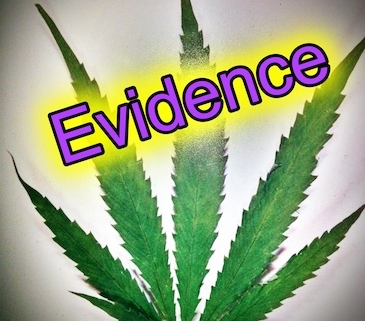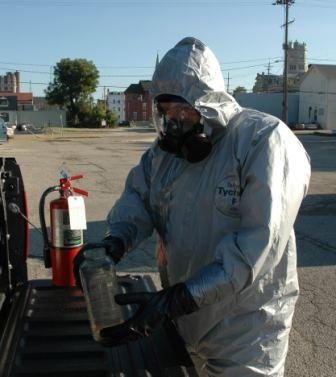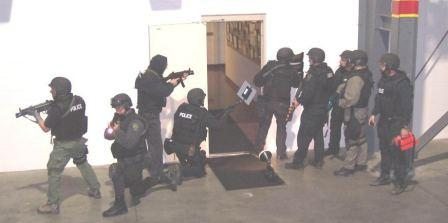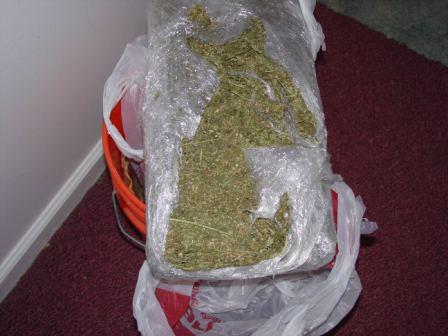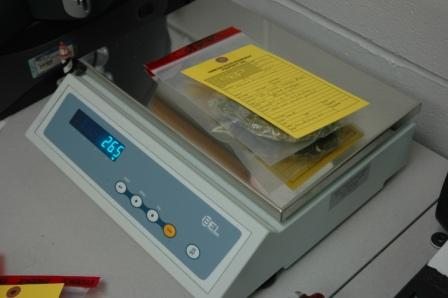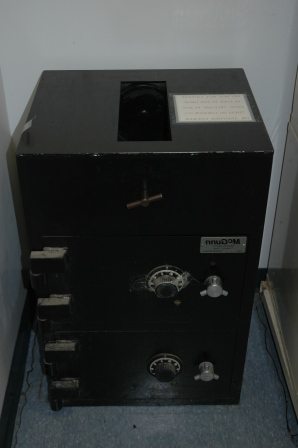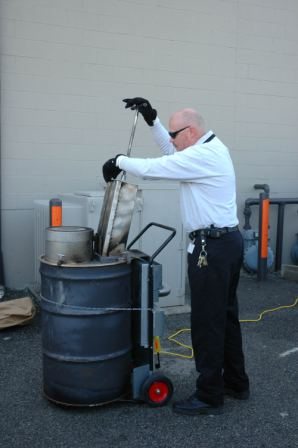Some crime scenes, such as labs used for manufacturing methamphetamine, contain hazardous materials—flammable and toxic chemicals and fumes. When searching those dangerous crime scenes investigators must wear protective gear and clothing. The same precaution is followed when it’s time to destroy drug evidence, such as the found methamphetamine.
A detective wearing a hazmat suit gathers evidence from a meth lab.
Drug Evidence and Storage
Narcotics officers spend a great deal of time conducting surveillance in some of the worst places imaginable, and they do it while enduring some pretty rough conditions. After all, it’s not pleasant sitting in a patch of poison ivy during a rainstorm while watching a bad guy conducting his business. And, the narcotics officers never know if they’ll be discovered, which could lead to a violent confrontation, possibly even a shootout.
Once the surveillance is over, and officers have established the necessary probable cause for obtaining a search warrant, it’s time to locate and seize the evidence. Tactical teams rehearse for this moment over and over again.
Entry team serving a search warrant
Bale (or brick) of marijuana discovered during a search.
Twenty-five pounds of freshly harvested marijuana (more in bags and boxes off screen).
Yes, that’s me in the photo above, and yes, that was my messy desk. In my defense, it had been a long week of day and night surveillance that led to a very long day of writing and serving search warrants.
Part of the long day included searching a wooded area where I’d previously discovered a fairly large grow operation.
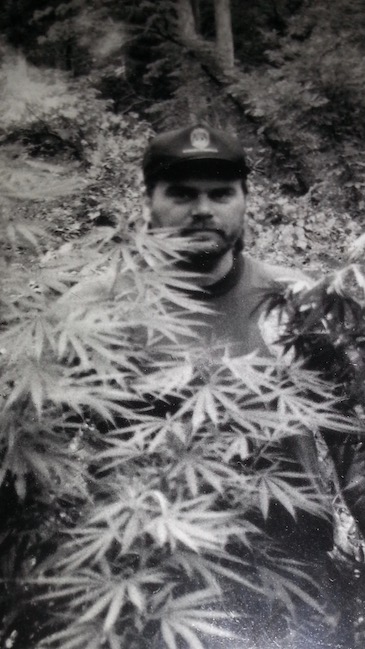
Again, that’s me in the photo above. The “plant” I’m standing behind was one of over 100 marijuana plants I found as a result of the surveillance and subsequent op. The plant above was a mere baby compared to the majority. The young ones were contained in plastic five gallon buckets. The larger plants were in the ground and had reached heights of 14 feet or more.
Remember, this was a while back when marijuana restrictions were much tougher. Still, an illegal operation of well over 100 plants would most likely be sternly frowned upon even today.
Property Room/Storing Drug Evidence
Above – A property room supervisor seen weighing a bag of marijuana.
No one has access to the evidence except the officers who work inside. If officers need a piece of evidence, they must sign for it, sort of like checking out a library book.
Scales for weighing narcotics evidence. The weight is recorded on the yellow evidence tag along with other pertinent case information.
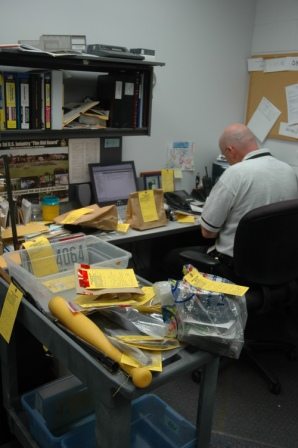
Evidence waiting to be cataloged
In some police departments above securely packaging and labeling items, officers deposit the evidence into an evidence safe. Once the items have been placed into the opening on the top of the safe they cannot be removed except by the property room supervisor.
Safes, like the one pictured below, are used during the nighttime hours when the property room officers are off duty. Once the items have been placed into the opening on the top of the safe they cannot be removed except by the property room supervisor.
Evidence safe
Each morning property room officers remove the items, catalog them, and then place the evidence into the property room or warehouse, or other secure storage facility. Some large agency evidence rooms are huge, like mini versions of the warehouses that supply big retail outlets such as Amazon, Costco, Walmart, Home Depot and Lowes.
After a drug case has made its way though the courts the evidence is destroyed, often by incineration.
Device used for destroying (burning) narcotics
INCINER8 is an example of a portable narcotics incinerator.
It goes without saying that it would not be safe to bring a quantity of a controlled substance into a courtroom. Nor would it be possible, for example, for officer to attempt to bring 5 tons of cocaine they’d seized from a ship or a tractor trailer. Therefore, a laboratory analysis indicating the type of drug, its weight, and level of purity, along with photos/video of the drugs and packaging and how they were transported, are most often presented as evidence in lieu off the actual drug, etc. The laboratory scientist or tech who conducted the analysis is often called upon to testify about the testing and procedure used to certify their findings and conclusions.
As stated above, incineration is a common method used to destroy seized drugs. Large quantities of illegal drugs are often incinerated by private contractors who destroy the narcotics/drugs. The DEA, for example, destroys large quantities of seized marijuana at EPA-approved incinerators.
Before incinerators, back in the day, we hauled hundreds upon hundreds of marijuana plants, some as tall as 12-18 feet, to a landfill where a group of us narcotics agents set the massive piles ablaze after soaking them with kerosene. Then a bulldozer was used to bury the ashes among the other garbage and debris—food waste, trash, old furniture and appliances, etc.
Then, for some odd reason, after the burn was complete, we always had the urge to stop at a local 7-11 to pick up a few bags of Doritos and M&Ms, and maybe a bit of chocolate ice cream, doughnuts, Pringles, onion dip, and maybe a pickled pigs foot or two. I don’t know why …
NARCAN By Noon
Join renowned instructor Sergeant James Yowell in his fascinating MurderCon class called Narcan By Noon.
Class Description – Drugs and death are deeply intertwined. Recent trends in drugs have led to an epidemic of deaths due to overdose, and created a compelling way to conceal a crime. Not all drug deaths are self-induced, and even when they are, they may be related to extraordinary activities by the user. This session will explore drug trends and mortality of drug users, and how can they determine overdose versus foul play.
Sergeant James Yowell is a twenty year veteran of the Fayetteville, North Carolina, Police Department. He was a counter drug investigator for 17 years, and he served as a Task Force Officer with the Drug Enforcement Administration for 9 years. As an undercover officer, Sergeant Yowell investigated international drug trafficking cases targeting Mexican organized crime, including street level drug “buys/sales” to a case agent.
MurderCon!
There’s still time to attend MurderCon, a unique event featuring hands-on workshops that are typically for law enforcement eyes ONLY!

To view MurderCon classes and workshops click HERE.
To sign up to attend this unique event for writers, readers, fans, and anyone who’s interested in attending actual hands-on law enforcement training at a renowned facility, click HERE.

